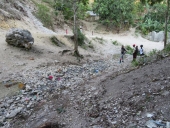
 9
9




 1
1




Jack Powers wrote:Quick summary: I have 40 acres in South West Washington. Its all steeply sloped, facing south west, and heavily forested. I've built 6 ponds so far, all in relatively dry spots, then fed with long reaching swales.
Today I attempted to dam up a steep valley/gulch, one where water flows year round. It was a complete failure. I dug out the start to the keyway, which ended up being nearly 10' deep before I found virgin clay (fully saturated with water). Then tapped out my dry clay stores just back filling the maybe 6' of keyway (which needs to be nearly 20') only to find that clay refused to be compacted due to all the water. Mind you, this was out side of the deepest part of the valley where the small stream is flowing.
\--v--/ imagine that is the cross section, and I was a single - into the keyway.
I also managed to get myself completely stuck trying to move up the valley to harvest more dry clay from the valley walls. (when they send the dozer to snatch me, I'll be sure to build temp log platforms to work from moving forward) but the real question remains.
How do I get the valley dry enough to build dam walls? Should I trench the flowing stream significantly then give the ground a few summer weeks to dry out (not convinced that will even allow it to dry due to the amount of uphill catchment)?
A build too cool to miss:Mike's GreenhouseA great example:Joseph's Garden
All the soil info you'll ever need:
Redhawk's excellent soil-building series









 2
2




 3
3




 2
2




"The rule of no realm is mine. But all worthy things that are in peril as the world now stands, these are my care. And for my part, I shall not wholly fail in my task if anything that passes through this night can still grow fairer or bear fruit and flower again in days to come. For I too am a steward. Did you not know?" Gandolf
 5
5




 2
2





'Every time I learn something new, it pushes some old stuff out of my brain.'
 1
1




 2
2




Jd
 2
2




 1
1








 2
2




Jack Powers wrote:Today I attempted to dam up a steep valley/gulch, one where water flows year round. It was a complete failure. I dug out the start to the keyway, which ended up being nearly 10' deep before I found virgin clay (fully saturated with water). Then tapped out my dry clay stores just back filling the maybe 6' of keyway (which needs to be nearly 20') only to find that clay refused to be compacted due to all the water. Mind you, this was out side of the deepest part of the valley where the small stream is flowing.
 4
4





|
We can walk to school together. And we can both read this tiny ad:
The new purple deck of permaculture playing cards
https://www.kickstarter.com/projects/paulwheaton/garden-cards
|







